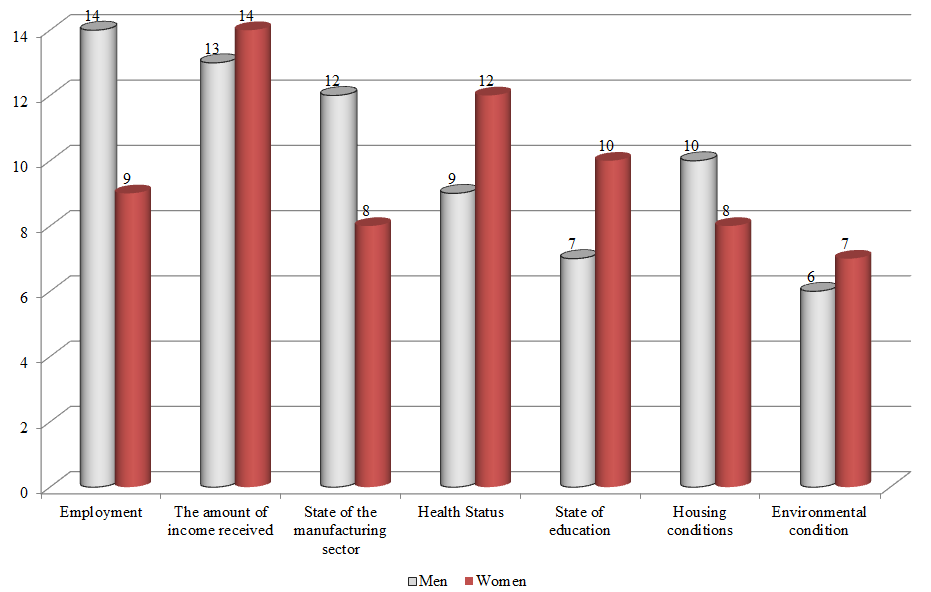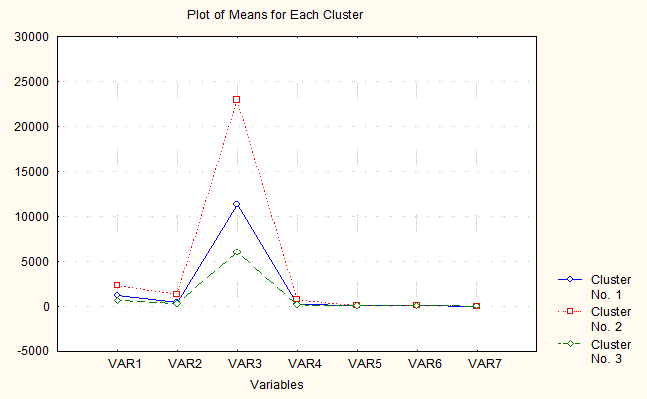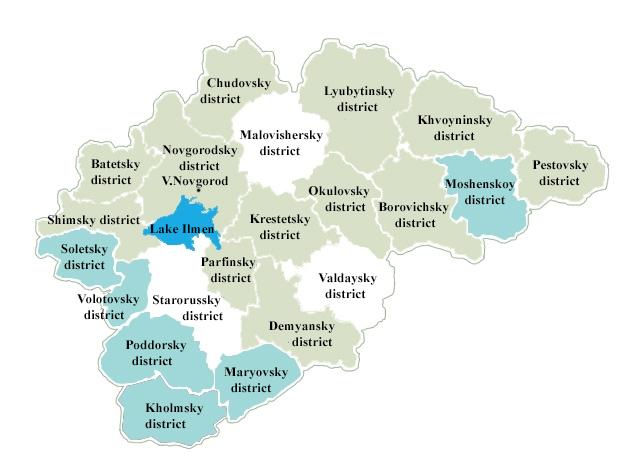Abstract
This article is devoted to updating and finding solutions to problems associated with the identification of socio-economic factors that determine the demographic situation in the Novgorod region municipalities. The result of the study presented in the article is a justified typology (set of clusters) of territories depending on the average values of the analyzed factors. The article presents the results of the analysis of the features of the development of territories and characteristics of the level of socio-economic development of the Novgorod region municipalities. The authors systematize a set of factors that determine the demographic processes in the region, among which economic-socio-ecological characteristics can be distinguished: employment of the population of the territories, income received, the state of the production and healthcare sectors, the level and quality of education, the living conditions of the population, and the environmental conditions. Thus, special emphasis is put on identifying the most significant grouping characteristics using methods of sociological research and the subsequent typologizing of the Novgorod region municipalities in accordance with the reasonable determinants of the demographic situation in the region based on cluster analysis. The study allowed the authors to conclude on the distribution of municipalities in the Novgorod region by type of demographic environment, taking into account the socio-economic factors that shape it and identify clusters of municipalities that require differentiated intervention by government authorities.
Keywords: Clusters of municipalitiesdemographic environmentdemographic potentialdemographic processesdemographic situationdeterminants of the demographic situation
Introduction
In the conditions of depopulation processes taking place in Russia, it is necessary to use new approaches to the implementation of socio-economic policies aimed at leveling and stabilizing the demographic situation of the territory.
Currently, the municipalities of the Novgorod region display significant differences in the rate of population decline, which is determined by the different level of socio-economic development of the territories. This fact actualizes the need to differentiate the municipalities of the Novgorod region into groups, taking into account the determinants of demographic processes and the construction of clusters of territories.
The applied tasks in the region that can be solved through the results of this study come from the May Decree and the Address of the President of the Russian Federation to the Federal Assembly, which he announced on February 20, 2019. In the Address, the President paid much attention to the development of social policy.
The Governor of the Novgorod Region Andrei Nikitin, who heads the working group of the State Council on Social Policy, identified five main areas of work:
birth stimulation;
poverty reduction;
migration;
a system of long-term care and a healthy lifestyle.
The listed areas are characteristics of demographic processes. Thus, the identification and argumentation of a set of factors (determinants) that determine the demographic processes (birth rate, mortality, migration, etc.) and the demographic environment (poverty level, unemployment rate, health status, etc.) allows solving the region’s problems in terms of demography.
Problem Statement
Currently, the Novgorod region has an unfavorable demographic situation, which is manifested in the annual decline in population. Over the past ten years, the population in the region decreased by 45.1 thousand people, the natural decrease was about 30 thousand people with an average annual population of the region of 635.1 thousand people.
Thus, there is an urgent need to study the prerequisites for the formation of an unfavorable demographic environment. The solution of the socio-economic problems of the region lies in the possibility of using recommendations by the executive and legislative authorities to develop priority areas of the demographic policy, taking into account the characteristics of a typological group (cluster), as well as the specifics of the socio-economic situation and demographic development of the region’s municipalities (Kislitsyna, Cheglakova, Karaulov, & Chikisheva, 2017). In the future, the clusters formed in the research work can become the basis for constructing a model of the territory of the Novgorod region, taking into account the socio-economic guidelines for the development of municipalities of the region, as well as the formation of territorial agglomerations.
In addition, the construction of clusters of territories according to demographic determinants makes it possible to ensure the targeting, and thereby the effectiveness of managerial decisions in the aspect of socio-demographic policy. As a result, the resulting regional practice can be proposed for scaling to the federal level.
The scientific significance of this work lies in the possibility of using the obtained research results in practical activities during the development and implementation of demographic policy programs both in the Novgorod region municipalities and the region as a whole.
Research Questions
What are the grouping indicators of the differentiation of municipalities according to the description of demographic processes?
What are the characteristics of the existing clusters of municipalities of the Novgorod region by type of demographic situation?
What are the types of demographic potential of municipalities in the Novgorod region?
Purpose of the Study
To substantiate the differentiation of municipalities of the Novgorod region according to the level of socio-economic development as factors determining the demographic situation in the region.
The aim defined specific objectives:
characterize the clusters of municipalities of the Novgorod region by type of demographic environment;
substantiate the possibility of forming territorial agglomerations in order to build a territory model taking into account socio-economic and demographic guidelines for the development of municipalities.
Research Methods
The research is based on the use of system analysis, technology for social monitoring of socio-economic phenomena and multivariate factor analysis of socio-economic processes.
The authors systematized a set of factors that determine the demographic processes in the Novgorod region through sociological observation - a sample survey of male and female population. The questionnaire survey provided a set of representative information from respondents.
The special research emphasis is on the identification of the most significant grouping characteristics and оn clustering the Novgorod region municipalities in accordance with the reasonable determinants of the demographic situation in the region.
The method of cluster analysis, according to Shubat and Shmarova (2017), allows completing the task of substantiating the types of demographic situation. Cluster analysis is based on the use of the concepts of a measure of similarity and difference and allows combining similar objects in one cluster and splitting different objects into different clusters. The result of applying this approach was the construction of clusters of the Novgorod region municipalities in accordance with the reasonable determinants of the demographic situation.
Findings
In the process of typologizing the municipalities of the Novgorod region according to socio-demographic determinants, the following algorithm was used:
Stage 1. Conducting a sociological study aimed at identifying factors that influence demographic development.
Stage 2. Conducting cluster analysis as one of the methods that studies multidimensional classifications according to the main grouping criteria. Using cluster analysis allows applying a differentiated approach to the substantiation of options for the condition and development of a particular territory (Shubat, Bagirova, & Akishev, 2019).
Stage 3. Calculation of a general indicator with the subsequent identification of the type of demographic environment of municipalities. The information obtained can serve as an empirical basis for forecasting and building medium-term forecasts for municipalities depending on the type of demographic environment and the demographic potential of territories (Gagarina, Dzyuba, Gubarev, & Fayzullin, 2017).
Thus, the above-mentioned stages and the methods used make it possible to achieve the aim, which in the future will allow making a demographic forecast and formulating regulation directions of demographic situation and demographic processes in the region, taking into account the peculiarities of the territories that constitute the region.
As a result of a sociological study, the purpose of which was to identify the characteristics determining the demographic processes in the Novgorod region, a sample survey of the population of the Novgorod region was conducted and the following information was obtained – Figure

Considering the peculiarities and limited statistical information on municipalities in the Novgorod region, we present in Table
The method of cluster analysis allowed determining the demographic characteristics immanent for municipalities in the Novgorod region.
As the initial data for the clustering of municipal regions, the values of all grouping indicators were selected (table

Figure
Turning to the typology of territorial entities by the level of socio-economic development proposed by Sivelkin and Kuznetsova (2003), as well as to the works of such scientists as Kolomak (2013), Kuznetsova (2013), Lyubimov, Lysyuk and Gvozdeva (2018), three clusters describing the demographic potential of the territories can be distinguished among the municipalities of the Novgorod region:
low level of potential for socio-economic development (stagnant type);
critical level (depressive type of demographic environment);
average level of socio-demographic determinants (a developing type of demographic environment).
The calculation of the general indicator with the selection of the type of demographic environment of municipalities in accordance with the clustering made it possible to construct a cartogram of the distribution of municipalities of the Novgorod region by type of demographic environment - Figure

The data in the figure shows the distribution of regions into the formed clusters. It should be noted that the most numerous is the cluster with a low level of development of the demographic environment - 13 municipalities, there are 6 territories with a critical level, and three municipal areas - Valday, Malovishersky and Starorussky - with an average level. For the further development of the Novgorod region as a whole, special attention should be paid to these groups of districts, and a strategy for supporting and developing the economy should be developed.
Conclusion
The stated problem is focused on the aspect of the distribution of municipalities of the Novgorod region by the type of demographic environment in territorial clusters that require differentiated intervention by government bodies.
The authors consider a combination of political, economic, social, environmental and technological factors that determine the demographic situation in the region, which allowed confirming the most significant ones, with the subsequent identification of grouping characteristics for differentiation of municipalities of the Novgorod region.
The purpose of the final research product is:
determining the type of demographic environment with consideration to socio-economic factors;
the formation of clusters, as a promising basis for constructing a territory model with consideration to socio-economic guidelines for the development of municipalities in the Novgorod region, as well as the formation of territorial agglomerations.
The research will allow the executive authorities in the region to understand the degree of differentiation of municipalities of the Novgorod region by socio-economic determinants that define the demographic situation of the region. Consequently, there is the possibility of a "point strike" use of leverage on the current socio-demographic situation and the achievement of:
alignment of the demographic situation of municipalities of the Novgorod region;
reduction of social tension in the municipalities of the region by implementing targeted social policies;
increasing the attractiveness of rural areas to the population.
In conclusion, it is worth noting that the potential opportunities for using the results of this study to solve applied problems in the region include:
1. Understanding of the socio-demographic situation, namely:
the degree of differentiation of municipalities of the Novgorod region by socio-economic determinants that define the demographic situation of the territories;
the presence of clusters of municipalities built according to the type of demographic environment and their characteristics;
the demographic situation for the medium-term planning horizon.
2. The choice of leverage on the current socio-demographic situation in the region.
3. Creation of a territorial agglomeration, a model of the territory, taking into account the socio-economic and demographic guidelines of municipalities, which makes it possible to scale up experience at the federal level.
Acknowledgments
The study was carried out with the financial support of the RFFS and the Government of the Novgorod Region in the framework of the research project "Substantiation of the territories differentiation by the level of their socio-economic development as the determinant of the demographic situation (case of municipalities of the Novgorod region) ", 18-410-530003.
References
- Fetisova, G. V., & Pritula, O. D. (2019). Justification of the factors determining demographic processes in the Novgorod region. Bulletin of the Novgorod branch of RANEPA. Veliky Novgorod, 9, 1 (11), 158-169.
- Gagarina, G. Y., Dzyuba, E. I., Gubarev, R. V., & Fayzullin, F. S. (2017). Forecasting of Socio-Economic Development of the Russian Regions. Ekonomika regiona, 13(4), 1080-1094.
- Kislitsyna, V. V., Cheglakova, L. S., Karaulov, V. M., & Chikisheva, A. N. (2017). Formation of the integrated approach to the assessment of socio-economic development of regions. Ekonomika regiona, 13(2), 369-380.
- Kolomak, E. (2013). Uneven Spatial Development in Russia: Explanations of New Economic Geography. Voprosy Ekonomiki, 2, 132-150.
- Kuznetsova, O. (2013). Pyramid of Factors of Regional Socio-Economic Development. Voprosy Ekonomiki, 2, 121-131.
- Lyubimov, I. L., Lysyuk, M. V., & Gvozdeva, M. A. (2018). Atlas of economic complexity, Russian regional pages. Voprosy Ekonomiki, 6, 71-91.
- Pritula, O. D., Davydova, S. G., & Fetisova, G. V. (2018). Сomparative Characteristics of Approaches to Differentiation of Elements Of Territorial Socio-Economic Systems. The European Proceedings of Social and Behavioural Sciences, 59, 464-473.
- Shubat, O. M., & Shmarova, I. V. (2017). Cluster Analysis as an Analytical Tool of Population Policy. Ekonomika regiona, 13(4), 1175-1183.
- Shubat, O. M., Bagirova, A. P., & Akishev, A. A. (2019). Methodology for Analyzing the Demographic Potential of Russian Regions Using Fuzzy Clustering. Ekonomika regiona, 15(1), 178-190.
- Sivelkin, V. A., & Kuznetsova, V. E. (2003). Features of a statistical analysis of the level of social development of municipalities. Questions of statistics, 12, 38-43.
Copyright information

This work is licensed under a Creative Commons Attribution-NonCommercial-NoDerivatives 4.0 International License.
About this article
Publication Date
31 December 2019
Article Doi
eBook ISBN
978-1-80296-076-1
Publisher
Future Academy
Volume
77
Print ISBN (optional)
-
Edition Number
1st Edition
Pages
1-1056
Subjects
Industry, industrial studies, project management, sustainability, business, innovation
Cite this article as:
Fetisova, G. V., Davydova, S. G., & Pritula*, O. D. (2019). Clustering Of Municipalities By Type Of Demographic Environment. In I. O. Petrovna (Ed.), Project Management in the Regions of Russia, vol 77. European Proceedings of Social and Behavioural Sciences (pp. 138-145). Future Academy. https://doi.org/10.15405/epsbs.2019.12.05.17
